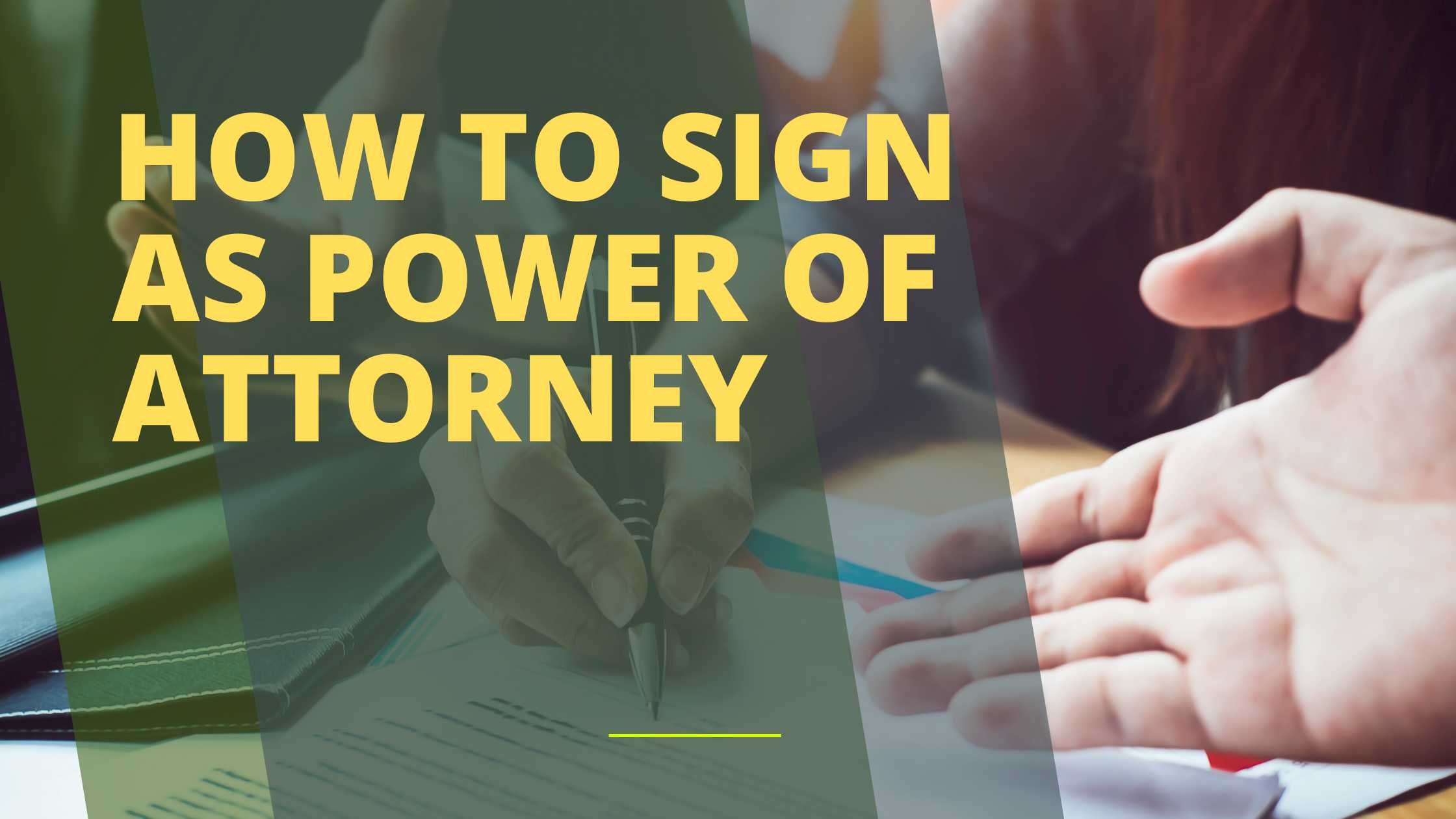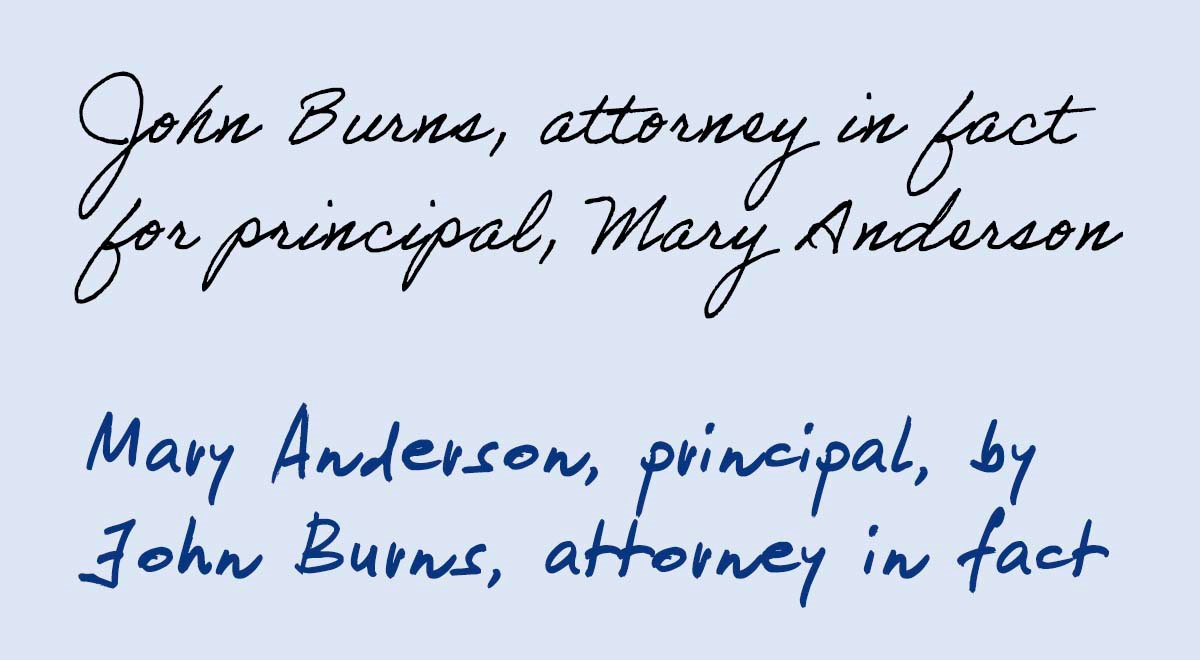How to Sign As Power of Attorney?

To sign as Power of Attorney (POA), the agent writes their own name with “POA” or “as Power of Attorney” after it. This indicates they are signing on behalf of the principal, not personally.
Signing as Power of Attorney authorizes an individual, known as the agent, to perform legal acts on behalf of another person, the principal. The POA provides essential legal capacity, allowing delegation of tasks such as managing financial matters or making healthcare decisions when the principal cannot do so themselves.
How to Sign As Power of Attorney? Ensuring proper signature and respecting the boundaries of the authority granted are vital to avoid legal issues. Agents should understand their role fully and comply with the documentation requirements specific to their jurisdiction and the powers outlined in their POA document. Being appointed as a POA carries responsibility and trust, necessitating careful compliance with legal standards to act in the principal’s best interest.
The Basics Of Power Of Attorney
The phrase “Power of Attorney” (POA) carries a significant amount of weight and responsibility. It is a legal document. It gives one person the right to act for another person. The person who creates the POA is the “Principal”. The person who gets the power is the “Agent” or “Attorney-in-fact”. Before diving into signing a POA, understanding the basics is crucial.
Legal Preconditions For Signing
To sign as a Power of Attorney, certain legal preconditions must be met. The Principal must be an adult. This means they must be 18 years or older. The Principal should understand what they are doing. The person needs to be of sound mind. This means they should know the consequences of the document. The signature must be voluntary, without force or pressure from anyone.
Key Points to Remember:
- Age: The Principal must be at least 18 years old.
- Mental Capacity: The Principal must understand the POA.
- Voluntary Signing: No one should force the Principal.
Different Types Of Power Of Attorney
POA comes in different forms, each serving a specific purpose. Knowing which type suits your needs is essential.
| Type | Purpose | When it’s Used |
|---|---|---|
| General POA | Covers broad actions | When the Principal can’t manage affairs |
| Durable POA | Remains in effect if Principal is incapacitated | For future planning |
| Limited POA | For specific tasks | When the Principal can’t manage certain affairs |
| Medical POA | For healthcare decisions | In case Principal can’t make decisions |
| Springing POA | Becomes effective upon specific conditions | When specific events occur |
Each type is unique. The General POA covers almost everything. The Durable POA continues if you can’t make decisions. A Limited POA applies only to certain things. The Medical POA lets someone else make health decisions. The Springing POA only starts under conditions you choose.

Credit: www.wikihow.com
Preparation Steps Before Signing
Acting as someone’s power of attorney (POA) is a significant responsibility. It demands careful preparation before you sign any documents. POA grants legal authority to act on another’s behalf. Understand the requirements and scope of your duties thoroughly before proceeding.
Verifying The Document’s Validity
Ensure the POA document is current and complies with state laws. Confirm with a legal advisor if necessary. The document must be free of errors or unclear language to be enforceable. Review it in the presence of a notary or attorney to confirm its legitimacy before signing. Here’s what you need to check:
- The date of the document – it must be recent and relevant.
- The principal’s signature – verify its presence and authenticity.
- Witness signatures – ensure they meet legal requirements.
- Notarization – confirm if it’s needed for legal validity in your state.
Understanding The Scope Of Authority
Comprehend the limits of what you can and can’t do as a POA. The document will define the extent of your powers. It may grant broad authority or limit you to specific actions. Always act in the best interest of the principal. To clarify your responsibilities, look for these details in the POA:
| Type of Authority | Description | Examples |
|---|---|---|
| Financial Decisions | Powers related to money and assets | Banking, investing, selling property |
| Healthcare Decisions | Medical-related authority | Treatment consent, accessing medical records |
| Special or Limited | Constrained to particular tasks | Filing taxes, representing in a legal matter |
Keep these preparations in mind to uphold the trust placed in you as a power of attorney. Proper understanding and verification are key steps to fulfill your role effectively and ethically.
Signing As Power Of Attorney
Understanding how to sign as Power of Attorney (POA) is crucial. The act carries significant legal weight. A POA allows a person—the “agent”—to make decisions for another—the “principal”. Signing must be correct to hold up legally. Let’s break down the process.
Required Signatory Information
Agents must know the required details before signing. These include:
- Principal’s full legal name: This must match the name on the POA document.
- Agent’s full legal name: Use the name as it appears on your identification.
- Exact POA title: Reference the document accurately to avoid confusion.
- Date of agreement: Include the date when the POA became effective.
Correct Signature Format
Signing must follow a specific format. See the table below for guidance.
| Step | Description |
|---|---|
| 1. | Write the principal’s name, followed by ‘by’. |
| 2. | Write ‘as POA’ to show authority. |
| 3. | Agent signs their own name underneath. |
Example: John Doe by Jane Smith as POA

Credit: www.nationalnotary.org
Common Mistakes To Avoid
Signing as a Power of Attorney (POA) requires caution. Avoid common errors to prevent legal troubles. These tips ensure clarity and compliance.
By following these guidelines, you can ensure your actions are legally sound and reflect the principal’s wishes accurately.
Mixing Personal And Principal’s Signatures
- Never mix signatures. Distinguish clearly between yours and the principal’s.
- Use the format “Principal’s Name by Your Name, Power of Attorney” to sign documents.
- Keep records separate to avoid confusion. Ensure to maintain the integrity of your actions on behalf of the principal.
Overstepping The Granted Authority
- Understand the limits. Only act within the permissions granted in the POA document.
- Consult the POA agreement before making decisions. This avoids legal pitfalls.
- If unsure, seek legal advice to clarify your authority.
Post-signature Actions
Once you’ve signed as a Power of Attorney (POA), the job isn’t finished. Taking the right steps after signing ensures everything runs smoothly. Ensure you manage your new responsibilities effectively by following these important post-signature actions.
Notifying Relevant Parties
As a newly appointed POA, your first task is to inform all necessary parties about your legal authority. Start with financial institutions, healthcare providers, and other entities requiring knowledge of your role.
- Create a list of entities to notify.
- Gather contact details for each party.
- Send official notice, including a copy of the POA document.
Keep a record of each notification sent for your files. Confirm receipt with each party to avoid future confusion.
Keeping Accurate Records
As a POA, keeping meticulous records is not just helpful, it’s essential. You’ll want to track every transaction and decision made on behalf of the principal.
| Date | Action | Reason | Outcome |
|---|---|---|---|
| MM/DD/YYYY | Transaction at Bank | Pay utility bills | Bills paid |
Use a digital spreadsheet or ledger to track actions. Document all expenditures and decisions. This protects you and the principal, ensuring transparency.
Legal And Ethical Considerations
Acting as Power of Attorney (POA) comes with critical legal and ethical obligations. People must understand how to perform this role responsibly. A POA agent makes decisions on someone else’s behalf, known as the principal. This position must be handled with utmost care to respect the principal’s wishes and legal rights.
Responsibilities Towards The Principal
Agents with POA bear a significant duty to act in the principal’s best interest. Below outlines these responsibilities:
- Act with Loyalty: Put the principal’s interests first.
- Keep Records: Document all decisions and transactions.
- Maintain Confidentiality: Protect the principal’s private information.
- Avoid Conflicts of Interest: Do not use the position for personal gain.
Consequences Of Misusing Power Of Attorney
Misusing a POA can lead to severe repercussions. Consider the following outcomes:
- Legal Action: The principal or concerned parties can sue for damages or to revoke the POA.
- Criminal Charges: If theft or fraud is involved, criminal charges may follow.
- Loss of Trust: Personal relationships may suffer irreparable harm.
Agents must perform their duties with transparency, maintaining trust and avoiding misuse of authority.

Credit: www.wikihow.com
Conclusion
Navigating the responsibilities as a power of attorney can be daunting, but clear guidance simplifies the process. Remember to act in the principal’s best interest and ensure all signatures are legally compliant. Consulting an attorney adds an extra layer of confidence.
Empower yourself with knowledge and conduct these important tasks with due diligence and care.
Amelia Justiceberg, a distinguished legal luminary, thrives on the intersection of empathy and legal acumen. As a prominent family law attorney, she orchestrates compassionate resolutions amidst complex dynamics. Justiceberg's courtroom finesse and dedication to fairness define her practice. Beyond litigation, she ardently advocates for social justice, solidifying her reputation as an influential force in the legal landscape.






